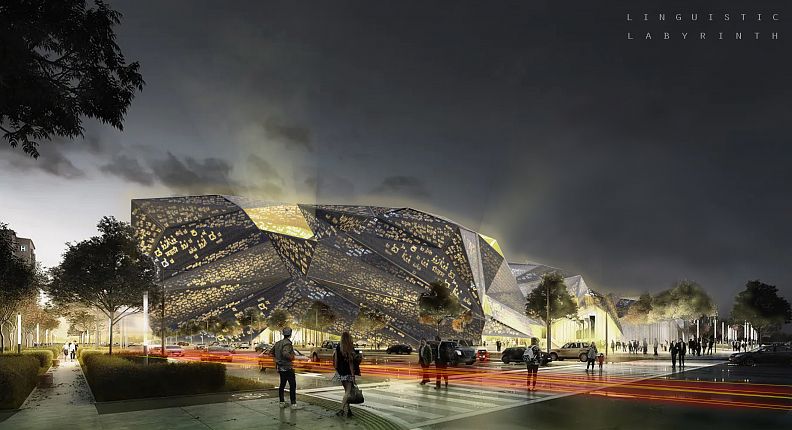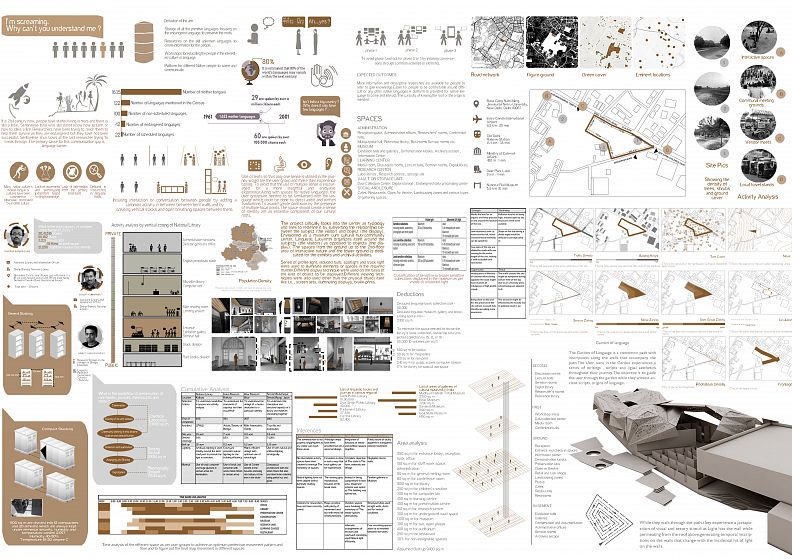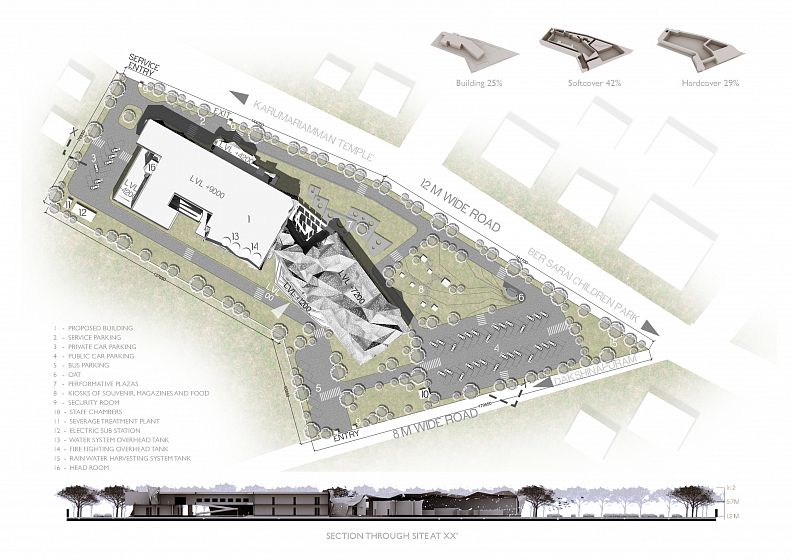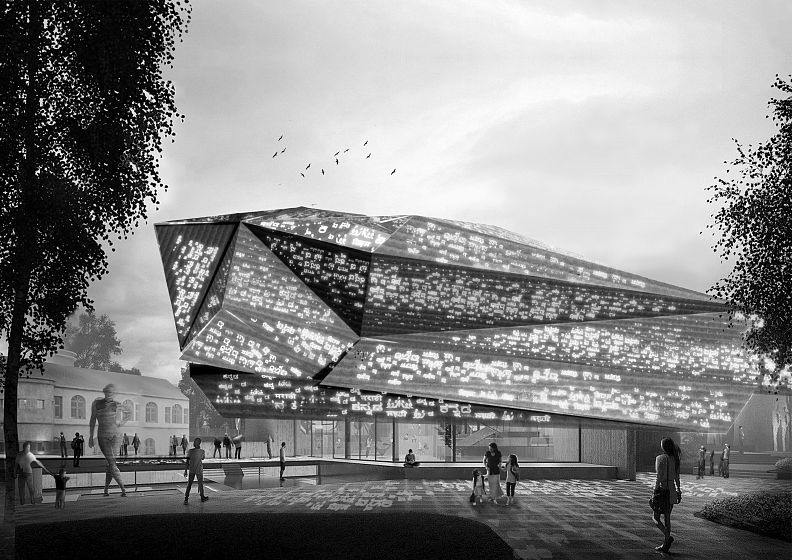Linguistic Labyrinth

Project idea
”Philosophy is written in this grand book, the universe, which stands continually open to our gaze. But the first book cannot be understood unless one first learns to comprehend the language and read the letters in which it is composed”
-Galileo Galilei
The lack of information on origin of languages leads to the necessity of preservation center, lack of knowledge and data on the languages leads to the necessity of research center, the lack of the system of derivation leads to the necessity of conservation center and the lack of awareness on this field leads to the necessity of a learning center, library, museum, exhibition and gallery.
The idea of the design is mainly to attract different tongue speaking people under one roof so as to remind them of their origin and for them to derive from their roots. The theme of this design is to generate interest and curiosity to spread awareness among people at a broader scale.
Most people know heritage when they see it. We travel to towns and cities to admire historic buildings. We visit museums to see artifacts from cultures past and present. But there are other ways history is passed down that are harder to hold onto and to recognize, even though they’re a daily part of life. They belong to what we call intangible heritage. As you can probably guess, language is a form of intangible heritage. It’s about so much more than spelling and grammar. Unfortunately, just like our historic buildings and natural environments, languages can disappear forever. This Research Centre and integrated Museum is part of a growing, global effort to preserve and celebrate languages and to educate the public about them. The mission is to promote all of the languages spoken in India. It’s a challenge, but it’s an important one.
Project description
Coming to the building, the spaces from the ground up to the 2nd-floor area of interactive nature and the lower ground is dedicated for the exhibits and archival activities. The overall arrangement of the program on the site and volumetric placement takes its cues from the historical development of the language. The basement houses permanent galleries of language, divided as per the genetic classification of language into families and a dedicated space for the archive. The first floor takes the second level of language engagement that is the focused speech. This level has an auditorium and seminar rooms. The top level of the museum houses the most advanced form of language, the written script. This floor is dedicated to a library with audiovisual facilities and learning centers. The central symbolising human brain covers an informal sitting area of the library dedicated to the formal discussions in an informal setting and generation and sharing of ideas. The communal space is followed by the the exhibition space where temporary display of physical aspects would be showcased. The way to the private section or the library upstairs or the learning sector is also through the exhibition space. The whole library and the stack racks are arranged in a broken continuous flow for avoiding any kind of negative space or dark corners.
This section is connected to the reception of the learning section followed by the microfilm reading room, the periodical reading room, map library, braille library and then the digital library below which consists of classrooms and audio visual rooms and a computer cell where all the varied aspects of languages are to be taught keeping in mind the interests of the mass.
Plates welded to angle cleats which are attached to the steel reinforcements by bracing wielding. The gutter for the rain water harvesting will seep through the pipeline between the steel reinforcement. The material that is used for the facades and sandwich panels is zinc. The finish of zinc panels can be smooth, but it is also possible to supply them with a patterned or weathered look. Each zinc wall cladding variation contributes to a certain sense of visual perception and can completely change the outlook of the built form.
For the façade skin use of zinc plates as a part of the distorted façade building material, perforated with varying linguistic syllables generates magnificent shadows on the floor that makes the visitor read while walking into the space also making it a conversation starter. The idea is to impart a sense of unity amongst the visitors and at the same time generate a sense of curiosity to explore the depths of the space.
The project critically looks into the center as typology and tries to redefine it by subverting the relationship between the subject (the visitor) and object (the display). Envisioned as a museum cum cultural hub/community center, Linguistic Labyrinth organizes itself around the subjects (the visitors) as opposed to objects (the display).
Technical information
Site: New Delhi
Site Area : 5 Acres
Linguistic museum, gallery and showcasing space area -2300 sq m To estimate the space needed to house the library’s book collection, divide the total projected collection by 15, 13, or 10 -50,000/10 volumes per sq ft600 sq m for books.
Deduced language book collection size - 50,000.
Deduced linguistic museum, gallery and showcasing space area -2300 sq m. To estimate the space needed to house the library’s book collection, divide the total projected collection by 15, 13, or 10 -50,000/10 volumes per sq ft600 sq m for books; 50 sq m for magazines; 120 sq m for non print; 240 sq m for public access computer station; 17% for library for special use space.
Area Analysis -
250 sq m for entrance lobby, reception, back office;
150 sq m for staff work space, administration; 50 sq m for general meeting room; 60 sq m for conference room; 1800 sq m for library; 250 sq m for children’s section; 300 sq m for computer lab; 450 sq m learning center; 400 sq m for preservation center; 150 sq m for research center; 300 sq m for underground vault space; 1300 sq m for museum; 300 sq m for oat, open plazas; 400 sq m for auditorium; 250 sq m for restaurant; 30% for non assignable spaces; Assumed Built up 9400 sq














